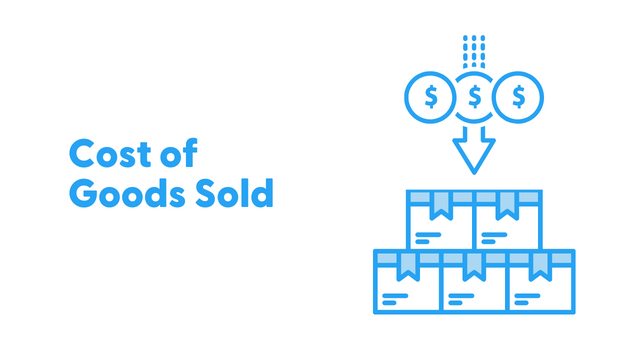COGS stands for “cost of goods sold.” It refers to the direct costs of producing and selling a product or service. These costs include materials, labor, and other direct expenses incurred in the production process.
The COGS is subtracted from a company’s revenue to calculate its gross profit.
How to Calculate COGS
The formula to calculate the “cost of goods sold” is:
COGS = Beginning Inventory + Purchases – Ending Inventory
- Beginning Inventory is the inventory value on hand at the beginning of the accounting period.
- Purchases are the total cost of goods purchased during the accounting period.
- Ending Inventory is the inventory value on hand at the end of the accounting period.
To calculate COGS, you would add the beginning inventory to the purchases, and then subtract the ending inventory. This will give you the total cost of goods sold during the accounting period.
Overhead costs, such as rent, utilities, and office supplies, are not included in the COGS formula as these costs are indirect costs and not directly tied to the production of the goods.
Inventory costs, such as the cost of raw materials and labor, are included in the COGS formula as these costs are directly tied to the production of the goods.
It’s important to note that COGS can be calculated on a per-unit basis or a total basis. COGS per unit can be calculated by dividing the total COGS by the number of units sold during the period.
Accounting for COGS
Once the cost of goods sold is determined, it is subtracted from the revenue generated from selling products or services during the same period. The result is the gross profit margin, which is a key measure of a business’s profitability and can be found on the income statement. It’s important to note that the cost of goods sold is a function of the inventory turnover, so it’s important to have accurate inventory records to calculate the cost of goods sold.
COGS relationship with Inventory Management
If a company has poor inventory management and holds too much inventory, it will tie up capital in excess stock and may result in higher storage and handling costs. This can ultimately increase the cost of goods sold. On the other hand, if a company has efficient inventory management and maintains just enough inventory to meet demand, it can minimize its carrying costs and potentially lower the cost of goods sold. Effective inventory management also helps minimize stockouts and lost sales, which can be beneficial in terms of cost.
Additionally, businesses must use the appropriate method of inventory accounting, such as FIFO (first in first out), LIFO (last in first out) or weighted average method, as this can affect the calculation of the cost of goods sold.
It’s also important to track and record any additional expenses such as freight or duties that are directly related to the purchased goods, as they will be part of the cost of goods sold.
7 Best Practices for Ensuring Accuracy in COGS Accounting
- Use a consistent method for valuing inventory: It’s important to choose and consistently use a specific method for valuing inventory, such as FIFO, LIFO, or weighted average method. This ensures that the cost of goods sold is calculated consistently from period to period.
- Keep detailed records: Maintain accurate and detailed records of all inventory transactions, including purchases, sales, and any adjustments made to the inventory balance. This will make it easier to track the cost of goods sold and ensure accuracy in the calculation.
- Conduct regular physical inventory counts: To ensure that the inventory balance is accurate, it’s important to conduct regular physical inventory counts and compare them to the records kept. Any discrepancies should be investigated and corrected as soon as possible.
- Monitor inventory turnover: Keep track of inventory turnover, which is the number of times the inventory is sold and replaced during the accounting period. A high inventory turnover can indicate that the cost of goods sold is accurately accounted for, while a low turnover may indicate that the inventory balance is overstated, or the cost of goods sold is understated.
- Keep track of all additional expenses: Track and record all additional expenses such as freight or duties that are directly related to the purchased goods, as they will be part of the cost of goods sold.
- Review and adjust accounts regularly: Review the cost of goods sold account regularly to ensure that all transactions are accurately recorded and that the account balances are accurate. Make any necessary adjustments to ensure accuracy.
- Use of software: Utilize inventory management software to automatically track inventory transactions and calculate the cost of goods sold. This can help prevent errors and improve efficiency.
Why should you factor in Cost of Delivery along with COGS
- For eCommerce businesses, the cost of delivery can include several variables, some of which are:
Shipping costs: This includes the cost of shipping the products to the customer, including the cost of packaging materials, postage or shipping fees, and any customs or duties charges. - Delivery or fulfillment center costs: This includes the costs associated with operating a delivery or fulfillment center, such as rent, utilities, and labor costs.
- Packaging costs: This includes the cost of packaging materials and any additional packaging costs, such as printing or labeling costs.
- Return shipping costs: This includes the cost of shipping products back to the business when a customer returns an item.
- Inventory carrying costs: This includes costs such as storage and handling associated with maintaining an inventory of products that are ready for shipment.
- Third-party logistics (3PL) costs: This includes costs for outsourcing the delivery of products to a third-party logistics company.
- Insurance costs: This includes the cost of insuring the products during shipping or storage.
- Technology costs include costs associated with using software and technology to facilitate the delivery process, such as shipping and tracking software, or warehouse management systems.
- Fuel costs: This includes the cost of fuel for delivery vehicles.
- Maintenance costs: This includes the cost of maintaining delivery vehicles, such as vehicles repairs and maintenance.
These are some of the variables that are included in the cost of delivery for eCommerce businesses, but this can vary depending on the specific business, the type of products being sold and the delivery method. It’s important for eCommerce businesses to keep track of these costs and factor them into calculating COGS to ensure accurate cost accounting and pricing.
Businesses should factor in the cost of delivery along with COGS for several reasons:
- Accurate cost calculation: Including the cost of delivery in calculating COGS ensures that the total cost of producing and selling a product or service is accurately reflected. This gives businesses a more accurate understanding of their gross profit margin and overall profitability.
- Proper pricing: By factoring in the delivery cost, businesses can ensure that they are pricing their products or services appropriately. This can help them to remain competitive in the market and avoid pricing their products too low and not being able to cover their costs.
- Better forecasting: By considering the cost of delivery in their financial projections, businesses can make more accurate forecasts for their future expenses and revenue. This allows them to plan for future expenses and adjust as needed.
- Better budgeting: Including the cost of delivery in their COGS helps businesses to budget more accurately, which can help them to manage their cash flow more effectively.
- Compliance: Depending on the nature of the business, there might be regulations or compliance requirements that require to include the cost of delivery in the calculation of COGS.
In summary, the cost of delivery is generally considered a direct cost and included in the calculation of COGS, and it’s not considered a variable cost and is not included in the calculation of contribution margin unless it is determined that it varies with the level of production or sales.
How can COGS Calculation Inform Pricing Decisions
Calculating the cost of goods sold (COGS) can inform pricing decisions by providing businesses with a clear understanding of the costs associated with producing and selling a product or service.
Here are a few ways that COGS can inform pricing decisions:
- Break-even analysis: By calculating the COGS, businesses can determine the break-even point, which is the point at which revenue equals the COGS. This can help businesses determine the minimum price they need to charge to cover their costs and make a profit.
- Margin analysis: By subtracting the COGS from the selling price of a product or service, businesses can determine their gross profit margin, which is a measure of profitability. By understanding the gross profit margin, businesses can better determine the optimal price for a product or service that will maximize profitability.
- Competitive pricing: By understanding their own COGS, businesses can better understand the prices of their competitors and make more informed pricing decisions.
- Bundle pricing: By understanding the COGS of each product, businesses can make better decisions on bundle pricing, which can help them to increase sales and profitability.
- Price elasticity: By understanding the COGS, businesses can better understand the price elasticity of their products or services, which is the responsiveness of demand to changes in price.
Also, read:
Conclusion
In conclusion, accurate calculation of COGS is a critical component of a detailed and accurate P&L report. This report is essential for making timely decisions that drive profitability for your eCommerce business. If you need help setting up an automated P&L report, let Saras Analytics assist you.
We can help you streamline the process and ensure that your COGS calculations are accurate and up to date. Contact us today to learn more about how we can help your eCommerce business thrive.












